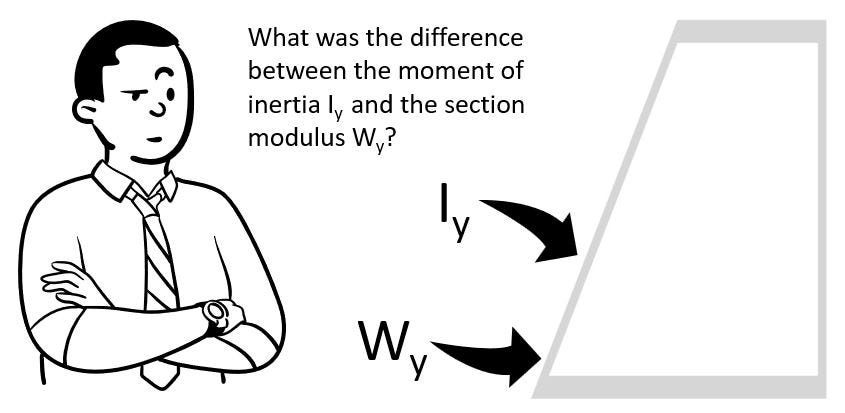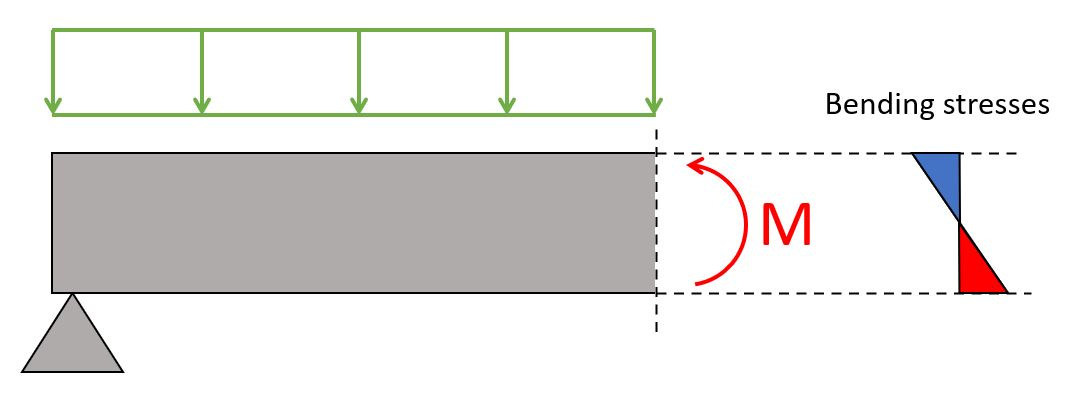What Is The Section Modulus?
And How Do We Use It In Structural Engineering 💡💡
Hi friends, 👋👋
The section modulus is used in many structural calculations. We’ll show a few of these later in the article. It also depends on the shape and dimensions of a cross-section as the moment of inertia. In fact, the section modulus and moment of inertia of a cross-section are very similar, and often times we can use one or the other.
In this Structural Basics episode, we’ll show you the difference between section modulus and moment of inertia. Welcome to post #14 of the engineering mechanics series.
Today we’ll cover:
First, what the section modulus of a cross-section is
How to calculate the section modulus and how it differs from the moment of inertia
Links to formulas for different cross-sections
Bonus tip: Quick calculation of the section modulus of complex cross-sections
So let’s get into it. 🚀🚀
What Is The Section Modulus?
The section modulus is a geometrical parameter in structural design that measures the bending strength of a cross-section. It’s used in the verification of elements that are subjected to bending, such as beams. With the section modulus, we can calculate the bending stresses in any point of a cross-section.
The section modulus depends on the dimensions of a cross-section, such as height and width. The greater the cross-section, the greater the section modulus and the bending resistance of a beam.
In general, there are 2 types of section modulus – the elastic and the plastic. When we talk about the section modulus in this post, we mean the elastic section modulus.
Before we look at the calculation of the section modulus, we have to clarify some concepts. We’ve already explained what a cross-section is in last week’s episode. We’ll repeat it to strengthen the understanding.
The section modulus is calculated by cross-sectional dimensions (height, width, etc.). In structural engineering, cross-sections are determined by cutting through a 3D structural object, like a beam, column, slab, etc. perpendicular to its length. This is visualized in the following picture, where the cross-section of an I or H beam is shown.
Some examples of where the section modulus is used in structural design/verification are:
Lateral torsional buckling verification of a steel beam (link to design guide)
Bending verification of steel beams (same link as lateral torsional buckling verification)
Calculation Of The Section Modulus And How Does It Differ From The Moment Of Inertia?
The section modulus is calculated as:
Now, let’s clarify that a bit more.
The section modulus is a geometric property of a cross-section as much as the moment of inertia, and we showed you how to calculate the moment of inertia in last week’s episode. So we can see that the section modulus is calculated from the moment of inertia. But it’s a bit different (keep reading to find out how).
A fibre of a cross-section is basically any point in a cross-section. For example, the marked point in the picture below.
In structural design, the fibre with the highest stress is mostly the one farthest away from the neutral axis (y and z) and therefore the section modulus is calculated for that fibre.
For the y-axis of a rectangular cross-section, that would be the bottom or top edge fibres. And it’s the left and right most outer fibres of a rectangular cross-section for the z-axis.
OK! So now let’s calculate the section modulus of a rectangular cross-section. AND as we just saw, we’ll calculate the section modulus of the fibres furthest away from the neutral axis y. 🧮🧮
So here are the geometrical properties of the cross-section.
To calculate the section modulus, we need the moment of inertia Iy and the distance from the neutral axis cz.
We calculated the moment of inertia extensively in last week’s newsletter, as:
The max. distance from the neutral axis y is in our case half of the cross-section height:
Now, let’s insert those 2 expressions into the formula. ⬇️⬇️
Voilà, this is the section modulus formula for the strong axis of a rectangular cross-section.
Now, let’s calculate the section modulus of an example cross-section. 👍👍
w = 100 mm
h = 240 mm
This results in a section modulus of the strong axis of: ⬇️⬇️
💡💡For symmetrical cross-sections, like rectangular and H-profiles the section modulus of top and bottom fibres are the same. However, if we have an unsymmetrical complex cross-section as in the example of the last section of today’s newsletter, the section modulus of top and bottom fibre is different. This leads to different bending moment capacities for positive and negative moments. 💡💡
However, this was only one example of the section modulus of 1 cross-section. Let’s have a look at what other sections exist. 👇👇
Moment Of Inertia Formulas Of Different Cross-Sections
Here’s an overview of the section modulus formulas for strong and weak axis for 8 of the most commonly used cross-sections.
And here’s the link to the article with calculation examples.
Bonus Tip: Quick Calculation Of The Section Modulus Of Complex Cross-Sections
As last week, we’ll show now a method how we can calculate the section modulus of complex cross-section (example cross-section from image below). We use the same tool Rhino and Grasshopper but a slightly different workflow.
1. We simply draw the geometry in Rhinoceros and create a surface from lines.
2. We then open Grasshopper.
3. In Grasshopper, we click on Surface, Analysis and Area Moments.
4. Right click on Geometry of the component, click on Set one Geometry and select the surface of the Cross-section.
5. Connect a panel with the output of the Area Moments component to see the result.
Now, we just connect the area output with the panel input, and we can see the calculated Moment of inertia. Be careful here❗, because the third value is the moment of inertia around the strong axis, while the first value is around the weak axis.
💡And the unit of the results is what you selected when Rhino was opened.
6. Right click on Centroid and click on Bake
Now, the centroid is a point in Rhino.
7. We can now measure the distance from the centroid to the most outer fibres.
Click on Linear Dimension >> Vertical Dimension
8. Click on the centroid point and a point on the top or bottom edge.
9. A tool like SMath can now be used to calculate the section modulus of the top fibre (and bottom fibre) from the moment of inertia and distance from the neutral axis (384.68mm). ⬇️⬇️
Now, of course you can also do this for the bottom fibre and for the section modulus of the weak axis.
Conclusion
This was already episode 14 of the engineering mechanics series. It’s gone quickly.
Next week, we’ll look at a special case: How to calculate the moment of inertia/section modulus of composite cross-sections, meaning a cross-section consisting of 2 materials.
See you next Wednesday for another Structural Basics newsletter. 🚀🚀
Have a great rest of the week and a fantastic weekend. ✌️✌️
I will have some time off, travelling to Gdansk in Poland with some of my friends.
Cheers,
Laurin.
Enjoy the newsletter? Please forward to a friend you think could like our structural engineering content. It only takes 14 seconds. Making this one took a few hours. Just forward this link: https://www.structuralbasics.com/newsletter/


























